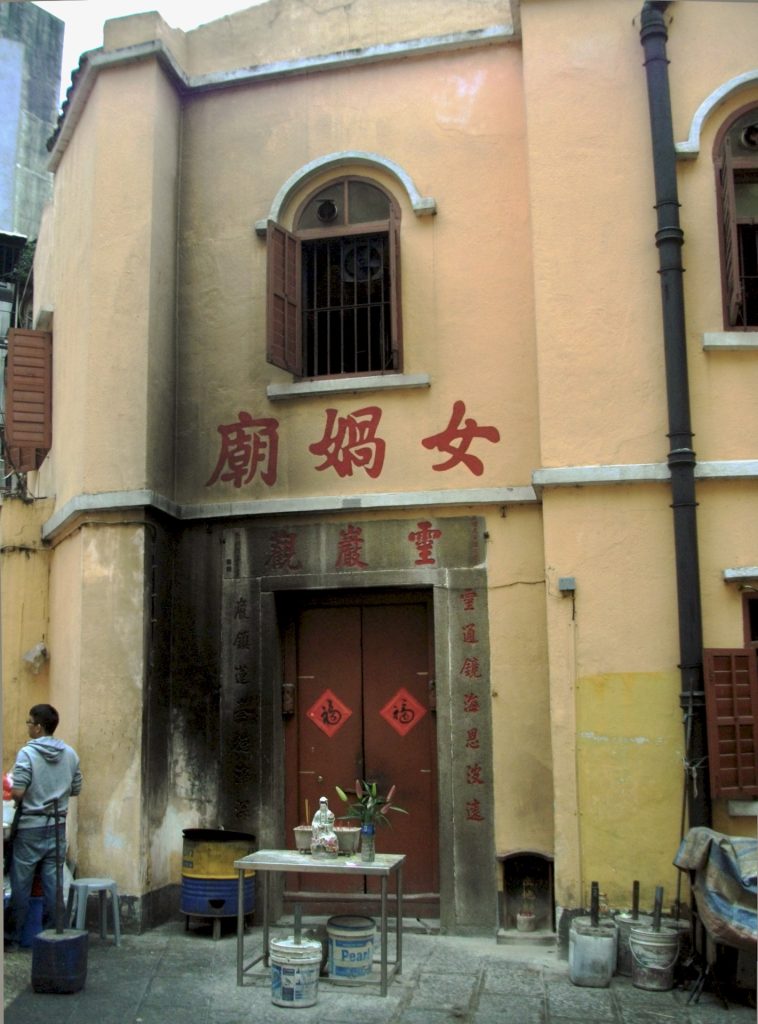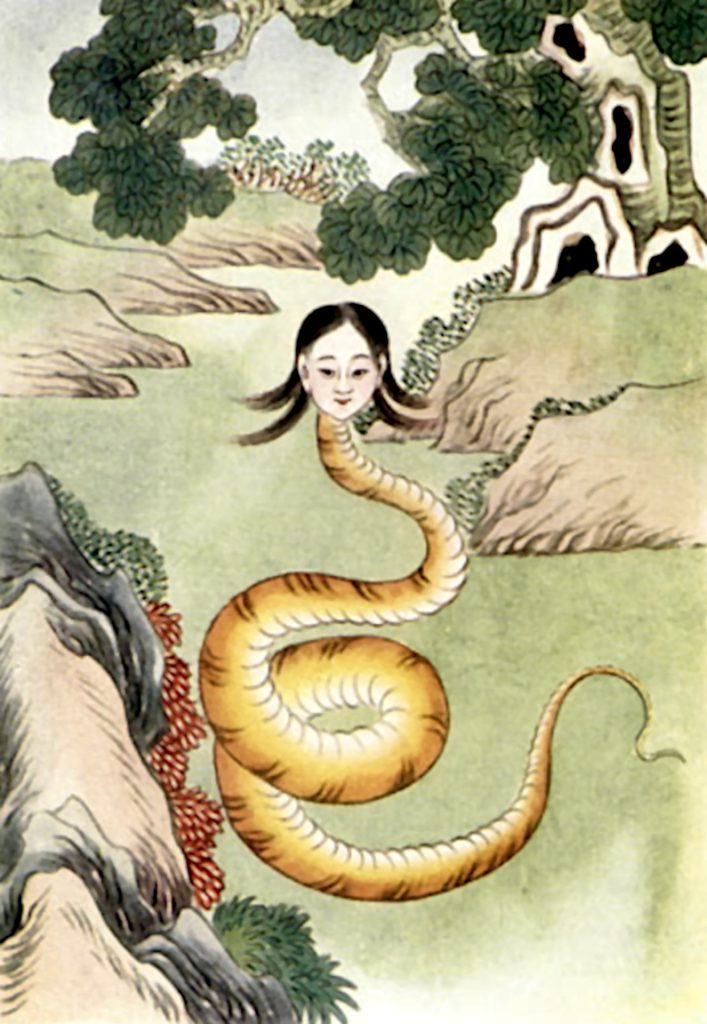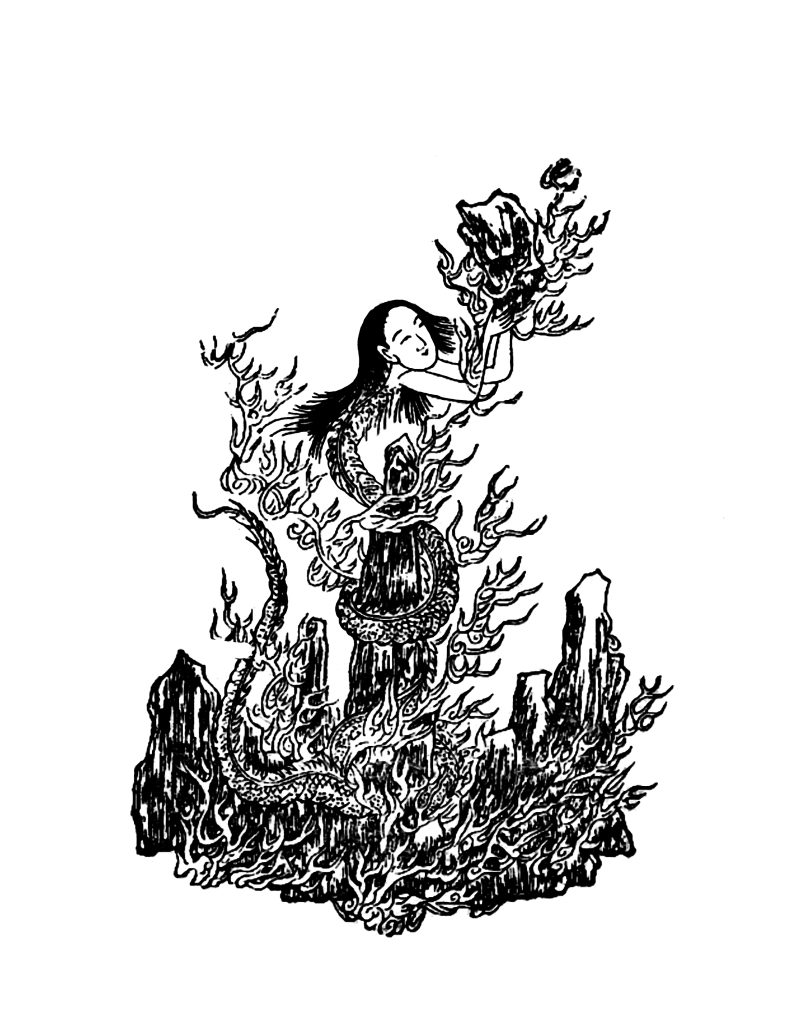Beginnings: Myths and stories from world religions
A curriculum for upper elementary grades by Dan Harper
Copyright (c) 2014-2022 Dan Harper
Updated 2022
Back to Table of Contents | On to Session 8
Nuwa: Two More Stories from China
Here are two more stories from China, both about the creator goddess Nuwa. Many different stories have been told about Nuwa in China, some dating as far back as 2,500 years ago. In some stories, Nuwa is an empress; in some stories she repairs the heavens; in other stories, she comes to the rescue when there is a great flood; in still other stories, she creates human beings. As is true of many myths, there are several different versions of each story; so there is no single “official” story about Nuwa.
In all the stories, though, Nuwa is a powerful goddess. She is a strong figure who sometimes has to stop disaster from happening, or fix things after a disaster has already happened.
Worship of Nuwa continues today, and as for Pangu, in some areas people hold temple fairs devoted to Nuwa.

Nuwa and the beginning of human beings
One of the great legendary emperors was Nuwa. She had the character of a divine sage, which is to say she was a goddess who was both wise and good. Nuwa had the body of a serpent and a head like a human being.

She roamed over the earth after the death of Pangu, when there was no one else in the world. The sky and the earth had been formed, but there were no human beings.
One day Nuwa stopped beside a calm pond to sit for a while. When she looked into the still, flat waters of the pond, she saw her own reflection, and realized with a start that there was no one else like her in the world. So she decided to make human beings.
She took up some earth that was about the color she wanted the human beings to be. With her hands, she began to mold it into the shape of a human being. When she placed this new creature on the earth, the first human being came alive, and began to move about. Soon the human being was dancing in the joy of being alive.
Nuwa was pleased with this first human beings she made, and so she made more. She made many different human beings, one after the other, carefully molding them with her hands. But after a while she began to grow tired, for it took great effort on her part to make the human beings, and it also took a great deal of time. She felt tired and drained, and thought she could not go on.
Nuwa had an idea. She took a long cord, and pulled it through the wet earth until it was well coated. Then she lifted the cord up, and shook it. Bits of earth came of the cord, and fell down to become human beings. These new human beings looked just as good as the ones she made by hand. And soon there were so many human beings that they spread all over the world.
But, so it is said, ever after there was a difference between the human beings that Nuwa molded by hand, and the ones she formed with the cord. The human beings that Nuwa molded by hand became the aristocrats: the rulers of the kingdoms and the people who held the power. The human beings that Nuwa created with the cord became the poor working people, the ones with little or no power.
Nuwa controls the flood
A story is told about a crisis that took place at the end of Nuwa’s reign.
One of the princes who ruled a fiefdom under the emperor Nuwa was named Gonggong. He was a water god, ruling over that one of the five elements. (The other five elements were air, fire, metal, and wood; Nuwa reigned under the element of wood.) Gonggong also was in charge of administering punishment when someone had done wrong. He had the body of a serpent and the head of a human being, and a head of red hair. Gonggong had a violent temper; he was ambitious, and wished to be more important than he really was.
Towards the end of Nuwa’s long peaceful reign as emperor, Gonggong thought he could overcome wood with water. He rebelled against the right way; as a ruler, he was a hateful tyrant, instead of a benevolent ruler who wanted the best for the people. Some people say that he cut down the mountaintops and high land, he filled in the low lands, and he dammed up the free-flowing rivers; and disasters and disorder spread everywhere. Be that as it may, he did engage in furious battle with Zhurong, god of fire.
When he lost the mighty battle with Zhurong, in his anger Gonggong struck his head against Mount Buzhou, which was one of the four pillars that held up the sky. Not only did he damage Mount Buzhou, he also damaged the other pillars of the heavens; and he broke the cords that held the earth together, which caused the corners of the earth to give way. Widespread disaster and destruction followed this foolish and angry action by Gonggong. The sky could no longer cover the earth, and holes appeared in it. Intense fires sprang up. Fierce wild beasts came forth to ravage and kill, violent birds swooped down to kill and then eat old people, children, and those who were weak, and the Black Dragon flew far and wide, killing and maiming. Floodwaters ran everywhere, but instead of ordinary floods, these floodwaters did not go down after a time; they kept on rising and rising, threatening to cover the whole world.
Nuwa melted stones of five different colors, and used them to patch the sky. She saw that the pillars that held up the sky were damaged beyond repair. She killed a giant tortoise and cut off its legs to support the four extremities of the heavens. She brought down the Black Dragon, and killed it to save human beings from destruction. The flood waters were still rising, so she gathered ashes of reeds, and used the ashes to stop the floodwaters.
Because of her efforts, the sky was renewed, the sky was supported on four solid pillars once again, the floodwaters were controlled, and all the lands became peaceful once more.
And some people say that once she had restored peace and stability to the world, Nuwa got into the chariot driven by the dragon Yinglong, and rode up into the heavens; and there she has lived ever since.
Sources and notes:
Nuwa and the first humans: Walls and Walls; the Fengsu Tongyi, as retold by Yang and An.
The Great Flood: Huainanzi, trans. Yang and An; with reference to Walls and Walls; and Myths and Legends of China, E. T. C. Werner.
For more sources on Nuwa, and a discussion of whether Nu Wa and Nu Gua are the same, see: Images of Women in Chinese Thought and Culture: Writings from the Pre-Qin Period Through the Song Dynasty, ed. Robin Wang (Indianapolis: Hackett Publishing, 2003), pp. 96-99.
For information about popular worship of Nuwa today, see: Popular Religion in China: The Imperial Metaphor, Stephan Feuchtwang (Routledge, 2001), p. 243. And: The Market and Temple Fairs of Rural China by Eugene Cooper (Routledge, 2012), pp. 55-56.
UNIT TWO: MYTHS OF COSMIC EGGS
Session Seven: Two more stories from China (Nuwa)
Attend the first part of the worship service with the rest of the congregation.
I/ Opening
Take attendance.
Light chalice with these words and the associated hand motions: “We light this chalice to celebrate Unitarian Universalism: the church of the open mind, the helping hands, and the loving heart.”
Check-in: Go around circle. Each child and adult says his or her name, and then may say one good thing and one bad thing that has happened in the past week (anyone may pass).
II/ Read the story
Read “Nuwa and the beginning of human beings” (see above).
III/ Act out the story
Act out the second half of “Nuwa and the beginning of human beings,” the story about Gonggong and the flood.
Ask: “What happened first in the story? Then what happened? then what happened?” — and so on, until (with your help and prompting as needed) the children have remembered what happened in the story.
Determine where the stage area will be. Children who are not actors may sit facing the stage area.
The lead teacher reads the story, prompting actors as needed to act out their parts. The lead teacher may wish to simplify the story on the fly, to make it easier to act out.
IV/ Conversation about the story
Ask some general questions: “What was the best part of the story for you? Who was your favorite character?” — or questions you come up with on your own.
Refer back to some previous stories: “Do you remember how Izagami and Izanami created the earth by dipping the jewelled spear into water? [session 2] Do you remember how Obatala created human beings by molding them out of clay? [session 3] How were these stories like today’s story? [You may want to go back and read parts of those stories to the children, to remind them.] How different?”
V/ Make illustrations of Nuwa
You might wish to make a series of drawings showing Nuwa making the first human beings. You could assign a different stage of the story to each child: Nuwa roaming the earth after the death of Pangu, Nuwa by the calm pond, Nuwa forming humans with her hands, Nuwa forming humans with the long cord, etc. This would form a continuation of the series of drawings about Pangu.
If you’re short on time, or as an alternative, you can use the Nuwa coloring page below.
While the children are drawing or coloring, engage them in conversation about the two types of human beings in the story. Was it fair for Nuwa to make two different kinds of human beings? Was it fair that one kind of human being got to rule over the other kind of human being? If you were one of the second kind of human being, how would you feel about it then?
VI/ Closing circle
Before leaving, have the children hold hands in a circle.
When the children are in a circle, ask them what they did today, and prompt them with questions and answers. If any parents have come to pick up their children, invite them to join the circle (so they can know what it is their children learned about this week).
When you’ve reviewed what the children learned for a couple of minutes, say together the unison benediction. Tell the children how you enjoyed seeing them (if that’s true), and that you look forward to seeing them again next week.
